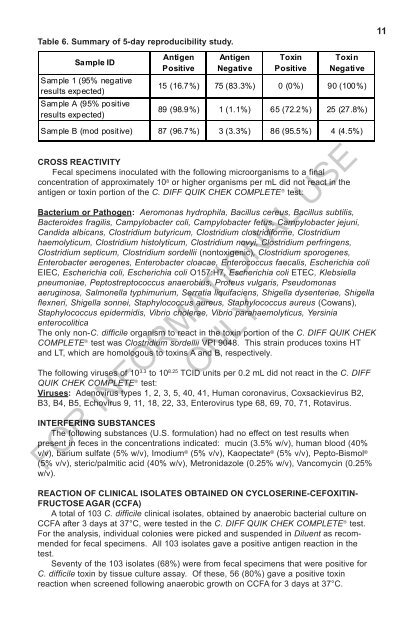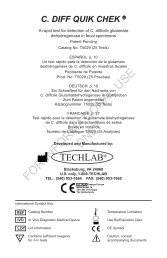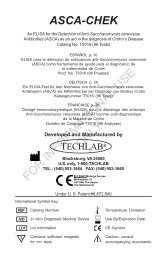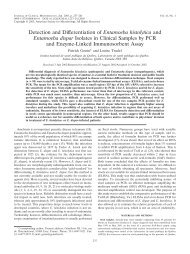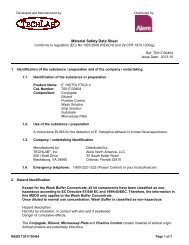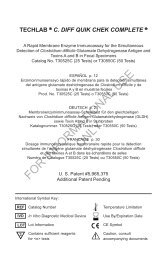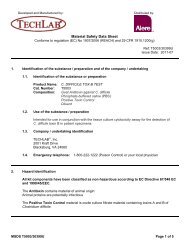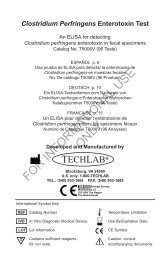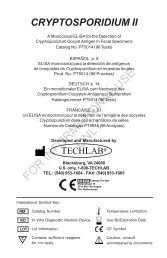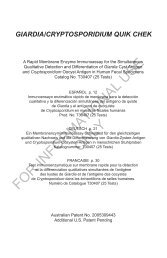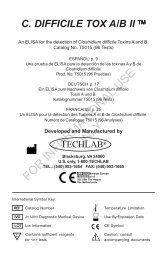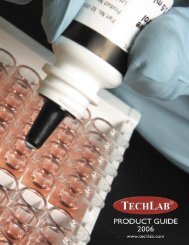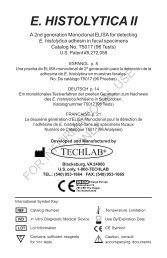Wampole C. DIFF QUIK CHEK COMPLETE 11-2011.pmd - TechLab
Wampole C. DIFF QUIK CHEK COMPLETE 11-2011.pmd - TechLab
Wampole C. DIFF QUIK CHEK COMPLETE 11-2011.pmd - TechLab
You also want an ePaper? Increase the reach of your titles
YUMPU automatically turns print PDFs into web optimized ePapers that Google loves.
Table 6. Summary of 5-day reproducibility study.Sample IDSample 1 (95% negativeresults expected)Sample A (95% positiveresults expected)AntigenPositiveAntigenNegativeToxinPositiveToxinNegative15 (16.7%) 75 (83.3%) 0 (0%) 90 (100%)89 (98.9%) 1 (1.1%) 65 (72.2%) 25 (27.8%)<strong>11</strong>Sample B (mod positive) 87 (96.7%) 3 (3.3%) 86 (95.5%) 4 (4.5%)CROSS REACTIVITYFecal specimens inoculated with the following microorganisms to a finalconcentration of approximately 10 8 or higher organisms per mL did not react in theantigen or toxin portion of the C. <strong>DIFF</strong> <strong>QUIK</strong> <strong>CHEK</strong> <strong>COMPLETE</strong> ® test:Bacterium or Pathogen: Aeromonas hydrophila, Bacillus cereus, Bacillus subtilis,Bacteroides fragilis, Campylobacter coli, Campylobacter fetus, Campylobacter jejuni,Candida albicans, Clostridium butyricum, Clostridium clostridiforme, Clostridiumhaemolyticum, Clostridium histolyticum, Clostridium novyi, Clostridium perfringens,Clostridium septicum, Clostridium sordellii (nontoxigenic), Clostridium sporogenes,Enterobacter aerogenes, Enterobacter cloacae, Enterococcus faecalis, Escherichia coliEIEC, Escherichia coli, Escherichia coli O157:H7, Escherichia coli ETEC, Klebsiellapneumoniae, Peptostreptococcus anaerobius, Proteus vulgaris, Pseudomonasaeruginosa, Salmonella typhimurium, Serratia liquifaciens, Shigella dysenteriae, Shigellaflexneri, Shigella sonnei, Staphylococcus aureus, Staphylococcus aureus (Cowans),Staphylococcus epidermidis, Vibrio cholerae, Vibrio parahaemolyticus, YersiniaenterocoliticaThe only non-C. difficile organism to react in the toxin portion of the C. <strong>DIFF</strong> <strong>QUIK</strong> <strong>CHEK</strong><strong>COMPLETE</strong> ® test was Clostridium sordellii VPI 9048. This strain produces toxins HTand LT, which are homologous to toxins A and B, respectively.The following viruses of 10 3.3 to 10 8.25 TCID units per 0.2 mL did not react in the C. <strong>DIFF</strong><strong>QUIK</strong> <strong>CHEK</strong> <strong>COMPLETE</strong> ® test:Viruses: Adenovirus types 1, 2, 3, 5, 40, 41, Human coronavirus, Coxsackievirus B2,B3, B4, B5, Echovirus 9, <strong>11</strong>, 18, 22, 33, Enterovirus type 68, 69, 70, 71, Rotavirus.INTERFERING SUBSTANCESThe following substances (U.S. formulation) had no effect on test results whenpresent in feces in the concentrations indicated: mucin (3.5% w/v), human blood (40%v/v), barium sulfate (5% w/v), Imodium ® (5% v/v), Kaopectate ® (5% v/v), Pepto-Bismol ®(5% v/v), steric/palmitic acid (40% w/v), Metronidazole (0.25% w/v), Vancomycin (0.25%w/v).FOR INFORMATIONAL USEONLYREACTION OF CLINICAL ISOLATES OBTAINED ON CYCLOSERINE-CEFOXITIN-FRUCTOSE AGAR (CCFA)A total of 103 C. difficile clinical isolates, obtained by anaerobic bacterial culture onCCFA after 3 days at 37°C, were tested in the C. <strong>DIFF</strong> <strong>QUIK</strong> <strong>CHEK</strong> <strong>COMPLETE</strong> ® test.For the analysis, individual colonies were picked and suspended in Diluent as recommendedfor fecal specimens. All 103 isolates gave a positive antigen reaction in thetest.Seventy of the 103 isolates (68%) were from fecal specimens that were positive forC. difficile toxin by tissue culture assay. Of these, 56 (80%) gave a positive toxinreaction when screened following anaerobic growth on CCFA for 3 days at 37°C.


